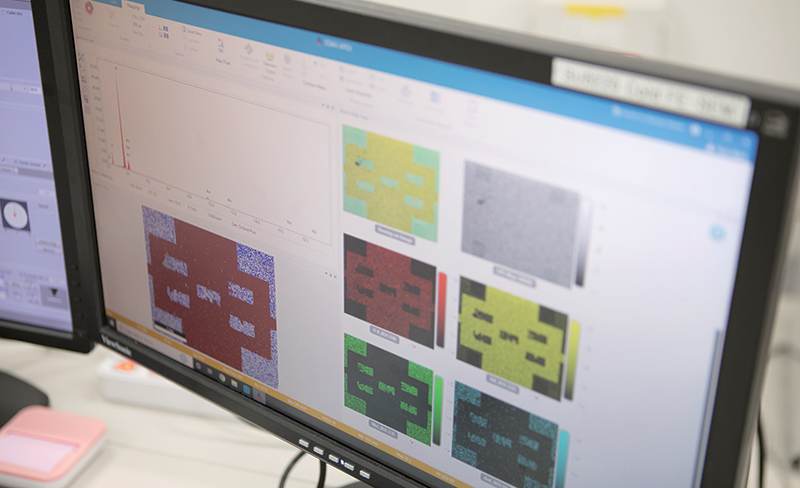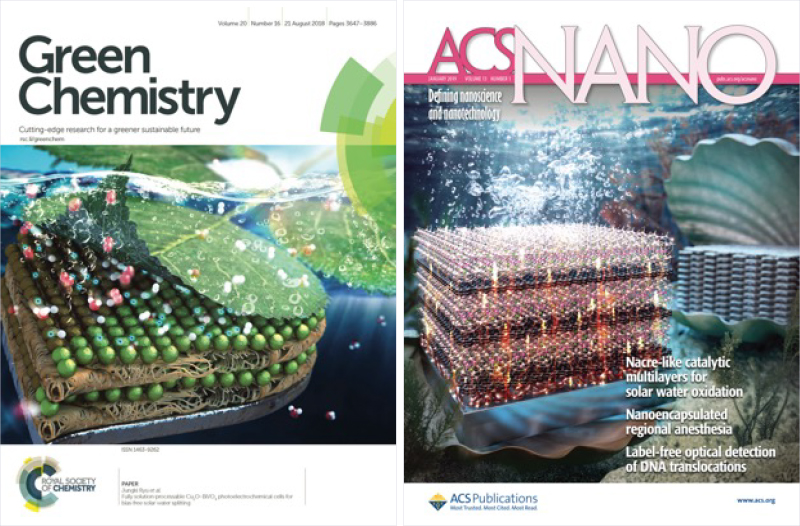
- INSIDE
- Special Theme _
NATURE INSPIRED TECHNOLOGY
본문영역
Development of carbon-neutral technology
using bio-inspiration
- Written by Professor Ryu Jungki of the Department of Energy and Chemical Engineering

The fruits and crises of the industrial and scientific revolutions
Industrialization and the scientific revolutions have helped humanity to enjoy a prosperous and peaceful life for almost the first time in its history. As we break down substances and systems into ever smaller units, we have come to better understand phenomena at the level of atoms and even smaller particles, thereby achieving material abundance through mass production based on simplification and componentization. All this made it possible to produce transportation fuels, heating fuels, plastics, and chemical products by using fossil fuels such as petroleum, coal, and natural gas, and to produce buildings and convenient devices by using metals such as iron, gold, silver, copper, cobalt, and nickel.
In the course of this process, however, humanity has failed to consider the balance with the Earth’s ecosystem, in which we live and on which we depend, and, as a result, energy and mineral resource depletion, environmental destruction, and rapid climate change problems now threaten our survival. Nanotechnology (NT), biotechnology (BT), and environmental technology (ET) have come under the spotlight as alternatives for solving these problems. For example, NT came under the spotlight in the early 1990s when carbon nanotubes and quantum dots were discovered, and this has since led to innovations in materials and energy technologies, as well as creating various synergies through convergence with BT and ET.

Biomimicry and bioinspiration technology
While humans only began to realize the possibilities of NT and BT at the end of the last century, nature has developed them for survival through evolution over tens or even hundreds of millions of years on Earth. Despite decades of research, the NT and BT created by humans still remains largely at the level of exploring simple substances and elemental technologies, whereas the NT and BT created by nature can efficiently perform highly complex functions by elaborately arranging functional materials at the molecular, nano, and micro levels. Furthermore, while the NT created by humans can only be implemented with the use of expensive rare metals such as gold, silver, copper, and cadmium, nature can perform the same functions much more efficiently by using elements that exist in abundance around living organisms.
The most representative example we can find around us is photosynthesis. Plants have cell organells called chloroplasts in which chlorophyll, which absorbs sunlight, an oxygen-evolving complex which extracts oxygen, a redox chain which can efficiently transmit photo-excited electrons, and a reaction center that uses photoexcited electrons to produce the APT and NAD(P)H required for life activities are elaborately arranged at the molecular level to produce various chemicals using only sunlight, carbon dioxide, and water. Even more surprising is the fact that it is possible to perform sophisticated chemical reactions using elements that are abundant on Earth, such as Mn, Ca, Fe, C, O, and N, rather than expensive precious metals, such as Ir, Pt, Rh, and Ru.
In addition to photosynthesis, there are countless examples of life systems around us that have created NT or BT themselves, such as the underwater adhesive protein of mussels, the bones that form the skeleton of our body, the sticky suckers of octopuses, lotus leaves with the ability to clean themselves, butterfly wings that create structural colors using microstructures, and the feet of gecko lizards, which can climb up walls and even walk on ceilings.
For this reason, biomimicry technology, which imitates natural substances and systems, and bioinspiration technology, which seeks to develop more advanced substances and systems through the reverse engineering of natural systems, are receiving much attention.
- (1)
- Bones and pearl nacre - Collagen, hydroxyapatite, and cells are elaborately arranged at the nano and micro levels and have excellent mechanical properties that can be used in the development of nanocomposite materials.
- (2)
- ) Photosynthesis — Chlorophyll, electron transport chains, enzymes, and inorganic substances are elaborately arranged to produce glucose from carbon dioxide and water using sunlight efficiently.
It can be used for artificial photosynthesis and solar cell development.
- (3)
- ) Enzymes – They exhibit high reactivity and selectivity by elaborately arranging transition metals and organic ligands, such as iron, manganese, and nickel, which are abundant in nature, instead of expensive metals such as platinum, gold, and iridium. They can be used in the development of low-cost, highly active catalysts.
- (4)
- Structural color – This refers to a phenomenon observed in butterflies and turkeys. By regularly arranging various materials in a region similar to the wavelength band of visible light, colors can be exhibited without dyes. They are utilized in the development of photonic crystals that stably produce color without any deterioration in performance due to photo-bleaching.
- (5)
- Protein adhesive – Development of submersible adhesives by mimicking the chemical properties of mussel adhesive protein.
- (6)
- Octopus sucker – Development of a mechanical adhesive patch by imitating octopus suckers.
- (7)
- Lotus leaves – Development of a super water repellent/self-cleaning surface using microstructure and wax coating.
- (8)
- Gecko lizards - They can climb walls by using the microfiber structure of their soles, which use van der Waals force. Adhesive systems that mimic this natural phenomenon can be developed.
- (9)
- Water striders – Not only can they move without falling into water by controlling the surface tension, but they can also jump very high, so they can be used in the development of a robot system based on this principle.
- (10)
- Hexagonal honeycomb structure – It can be used to develop high-efficiency/high-performance structural materials.
- (11)
- Shark skin – Protrusions on the skin function in a way that significantly reduces resistance in the water. It is used in the development of full-body swimsuits with little resistance in the water. Development of artificial photosynthesis technology for carbon neutrality
Development of artificial photosynthesis technology for carbon neutrality
Professor Ryu Jeong-ki's laboratory in the Department of Energy and Chemical Engineering is developing an artificial photosynthesis system that simulates or mimics plant photosynthesis, which produces glucose using limitless sunlight, water, and carbon dioxide.
Natural photosynthesis can efficiently produce the various chemicals necessary for plant growth, but because of this, the production efficiency for specific chemicals is not very high. Moreover, since plants have a self-healing function, photochemical reactions can be stably performed over a long period using organic dyes such as chlorophyll, but stability may decrease when using only specific systems within plants. Therefore, it is essential to develop reverse engineering into an artificial photosynthesis system that can produce specific desired chemicals (for example, hydrogen that can be used as a clean fuel, or hydrocarbons that can be used as raw chemical materials) with high efficiency based on a deep understanding of natural photosynthesis systems that can utilize infinite sunlight. Professor Ryu’s laboratory is researching and developing a photoelectrochemical system that produces hydrogen from sunlight by elaborately assembling light-absorbing materials, oxidation catalysts, and reduction catalysts like a natural photosynthesis system. For example, it is possible to precisely assemble the desired materials at the desired position and in the desired order through electrostatic attraction provided that the electrostatic charge of each material under an aqueous solution is well controlled. Moreover, research is also being carried out to improve photosynthetic efficiency by controlling the ligand environment surrounding the catalyst, as in natural photosynthesis.

Development of technology to improve water electrolysis efficiency by simulating the effects of petals
In addition to artificial photosynthesis, the laboratory is researching the surface modification of water electrolysis electrodes by simulating the effects of lotus leaves. Lotus leaves have a self-cleaning function that causes water droplets to roll off their surface easily, and without wetting the surface, thanks to the microporous structure of the surface and a hydrophobic wax coating. This is called the “lotus effect”. Through joint research with Professor Lee Dong-wook’s laboratory in the Department of Energy and Chemical Engineering, this research team has developed a super-oleophobic technology that allows air droplets, instead of water droplets, to fall easily from the surface of a substrate in water by reverse engineering the lotus leaf’s structure.
If a solid surface is coated with a hydrophilic hydrogel that has fine pores and is very receptive to water, it is difficult for gas droplets to adhere to the solid surface, or gas droplets already attached can be easily removed. This research team is developing a technology for improving water electrolysis efficiency by applying it to a water electrolysis system. Water electrolysis is a reaction in which water is decomposed to produce hydrogen and oxygen. The gas produced by the reaction adheres to the electrodes that perform the water electrolysis reaction, reducing the efficiency of water electrolysis. The team discovered that water electrolysis efficiency could be dramatically improved by coating the super-anaerobic hydrating gel developed by the research team on to an electrolysis electrode without developing a new catalyst, and follow-up studies are underway.
Trends in biomimetic/biomimicry technology research at UNIST
Nature and life systems have evolved into forms that make the most of a given environment and minimize the impact on the surrounding environment. Therefore, they may already have answers to many of the problems that humanity currently faces. Although we may not be able to find answers to all the problems we face in nature, nature already gives us many hints about the efficient use of energy and resources most closely related to human survival. At UNIST, in addition to this laboratory, many research teams are actively researching various topics related to biomimetics and biomimicry, and it is expected that they will continue to produce innovative research results.
Laboratories of Professors Lee Jae-sung, Jang Ji-yeon, and Jang Ji-wook in the Department of Energy and Chemical Engineering and Professor Cho Han-hee in the Department of Advanced Materials Engineering: Development of artificial photosynthesis technology
by Professor Lee Dong-wook’s laboratory in the Department of Energy and Chemical Engineering Bio-mimic adhesive/adhesive material development
by Professor Cho Jae-heung's laboratory in the Department of Chemistry: Research on biomimetic organic/inorganic coordination chemistry
by Professor Jung Hoon's laboratory in the Department of Mechanical Engineering: Research on biomimetic antifouling technology, robotics, and BT devices

